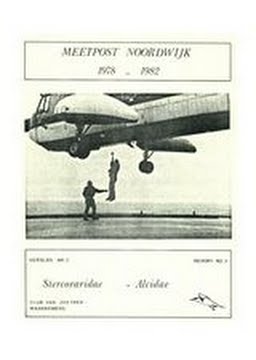1988
Stercorariidae – Alcidae
Publication
Publication
Speciale Verslagen Club voor Zeetrekwaarnemers , Volume 3 - Issue 1 p. 71- 107
This is the third and final report on the passage, as observed from an offshore platform "Meetpost Noordwijk"(MpN), during the period 1978-1982. This report, covering Stercorariidae – Alcidae, has been preceded by Camphuijsen et.al.(1982), covering Gaviidae – Ardeidae, and Den Ouden & Camphuijsen (1983), covering Anatidae – Scolopacidae. In contrast to the previous two reports, which were based on the observations from 1978 until 1981, this report also includes the data gathered in autumn 1982. There is a remote chance that the non-seabirds will be summarized in Sula. A complete survey of the observation-hours is given in ch. 11.3. For information concerning the MpN, methods and data-representation, see Camphuijsen et.al. (1982) Chapter 11,A gives the total numbers of the birds, discussed in this report. Chapters 12, 13, 14 and 15 are species accounts, of which only the relevant species will be summarized here. -Chapter 12 (Stercorariidae); Arctic Skuas were only seen in some numbers in autumn (AUG/SEP-NOV). The largest numbers were seen in AUG, flying south. Numbers at the MpN were always smaller than along the (Dutch) coast. Great Skuas were only seen in autumn (SEP, OCT), while the numbers exceeded the coastal numbers. -Chapter 13 (Laridae): Little Gulls showed directional passage both in spring (APR/MAY) and in autumn (OCT/NOV), although migration was strongly peaked. Both in autumn and in spring, numbers were usually below those, observed along the coast. Black-headed Gulls were commonly seen in spring, in low numbers; in autumn (esp. OCT-NOV) fairly strong south bound passage was observed. The observed numbers never exceeded the coastal passage. Common Gulls were commonly seen in MAR and APR in larger numbers (esp. MAR), but with less directional passage than along the coast. The proportion of immatures in spring at the MpN was high in MAR/APR, dropping to 50% in MAY, thus showing a trend opposite to the one observed along the coast. In autumn the passage was not strongly directional, with most birds seen from late OCT onwards; early autumn showed low numbers, but OCT/NOV were comparable to the coast. The proportion of immatures in autumn reached a maximum in OCT, while the adults peaked in NOV. Lesser Black-backed Gulls were regularly seen at the MpN, but only in late AUG and SEP large numbers were seen flying southward; during this period numbers were comparable to the coastal numbers. The birds were present in autumn for a longer period than is usual along the northern part of the coast, but comparable to the southern part. Great Black-backed Gulls were seen regularly in march. In autumn the species was quite common, with lowest numbers in SEP. Compared to the coast, passage in spring was more massive, but less directional at the MpN, while autumn migration was more strongly southbound and in larger numbers. Herring Gulls were almost continually present in spring, with no clear directional passage. In autumn migration was quite clearly southbound and the birds were only from NOV onwards more or less continually present. For this species there are no coastal data available for comparison and at the MpN the species has not been recorded systematically in 1978 and autumn 1979. Kittiwakes were not seen in any numbers in spring. In autumn, however, large numbers were observed in OCT/NOV, presence exceeding coastal data, while numbers were comparable. Chapter 14 (Sternidae); Sandwich Terns were seen in spring from MAR 30th onwards, with largest numbers late APR. In autumn large numbers were seen late AUG/early SEP, flying southward; numbers decreased soon afterwards. "Comic Terns" showed fair numbers flying north late APR/MAY and large southbound numbers late AUG/SEP. In autumn, from OCT onwards, numbers were minimal. In spring 15% of the birds were specifically identified; of these 61% were Arctic Terns; in autumn these figures were 25% and 19% respectively. Chapter 15 (Alcidae): Razorbills/Guillemots were seen in fairly large numbers in spring, compared to the coast. In autumn most birds were seen in OCT/NOV , in numbers comparable to the northern coastal areas. In spring 23% of the birds seen were specifically identified; of these 17% were Razorbills; in autumn these figures were 18% and 16% respectively, with Razorbills occurring earlier in autumn than Guillemots.
| Aanvullende gegevens | |
|---|---|
| Speciale Verslagen Club voor Zeetrekwaarnemers | |
| Organisatie | Nederlandse Zeevogelgroep |
|
J.E. den Ouden & N.F. van der Ham. (1988). Stercorariidae – Alcidae. Speciale Verslagen Club voor Zeetrekwaarnemers, 3(1), 71–107. |
|
